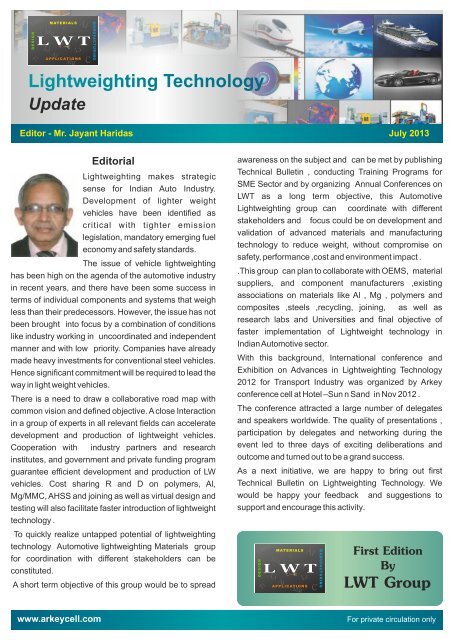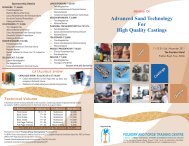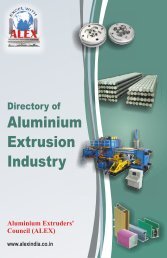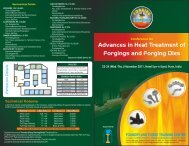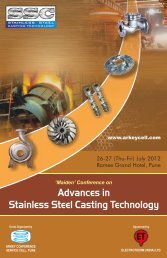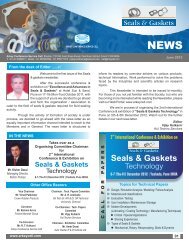LWT - Arkey Group
LWT - Arkey Group
LWT - Arkey Group
You also want an ePaper? Increase the reach of your titles
YUMPU automatically turns print PDFs into web optimized ePapers that Google loves.
UHSS<br />
D E S I G N<br />
Ti<br />
Mg<br />
M AT E R I A L S<br />
L W T<br />
Li<br />
Al<br />
C<br />
Ti<br />
Mg<br />
A P P L I C AT I O N S<br />
Al<br />
Li<br />
C<br />
M A N U FA C T U R I N G<br />
Lightweighting Technology<br />
Update<br />
Editor - Mr. Jayant Haridas<br />
July 2013<br />
Editorial<br />
Lightweighting makes strategic<br />
sense for Indian Auto Industry.<br />
Development of lighter weight<br />
vehicles have been identified as<br />
critical with tighter emission<br />
legislation, mandatory emerging fuel<br />
economy and safety standards.<br />
The issue of vehicle lightweighting<br />
has been high on the agenda of the automotive industry<br />
in recent years, and there have been some success in<br />
terms of individual components and systems that weigh<br />
less than their predecessors. However, the issue has not<br />
been brought into focus by a combination of conditions<br />
like industry working in uncoordinated and independent<br />
manner and with low priority. Companies have already<br />
made heavy investments for conventional steel vehicles.<br />
Hence significant commitment will be required to lead the<br />
way in light weight vehicles.<br />
There is a need to draw a collaborative road map with<br />
common vision and defined objective. A close Interaction<br />
in a group of experts in all relevant fields can accelerate<br />
development and production of lightweight vehicles.<br />
Cooperation with industry partners and research<br />
institutes, and government and private funding program<br />
guarantee efficient development and production of LW<br />
vehicles. Cost sharing R and D on polymers, Al,<br />
Mg/MMC, AHSS and joining as well as virtual design and<br />
testing will also facilitate faster introduction of lightweight<br />
technology .<br />
To quickly realize untapped potential of lightweighting<br />
technology Automotive lightweighting Materials group<br />
for coordination with different stakeholders can be<br />
constituted.<br />
A short term objective of this group would be to spread<br />
awareness on the subject and can be met by publishing<br />
Technical Bulletin , conducting Training Programs for<br />
SME Sector and by organizing Annual Conferences on<br />
<strong>LWT</strong> as a long term objective, this Automotive<br />
Lightweighting group can<br />
stakeholders and<br />
coordinate with different<br />
focus could be on development and<br />
validation of advanced materials and manufacturing<br />
technology to reduce weight, without compromise on<br />
safety, performance ,cost and environment impact .<br />
.This group can plan to collaborate with OEMS, material<br />
suppliers, and component manufacturers ,existing<br />
associations on materials like Al , Mg , polymers and<br />
composites ,steels ,recycling, joining,<br />
as well as<br />
research labs and Universities and final objective of<br />
faster implementation of Lightweight technology in<br />
Indian Automotive sector.<br />
With this background, International conference and<br />
Exhibition on Advances in Lightweighting Technology<br />
2012 for Transport Industry was organized by <strong>Arkey</strong><br />
conference cell at Hotel –Sun n Sand in Nov 2012 .<br />
The conference attracted a large number of delegates<br />
and speakers worldwide. The quality of presentations ,<br />
participation by delegates and networking during the<br />
event led to three days of exciting deliberations and<br />
outcome and turned out to be a grand success.<br />
As a next initiative, we are happy to bring out first<br />
Technical Bulletin on Lightweighting Technology. We<br />
would be happy your feedback<br />
support and encourage this activity.<br />
UHSS<br />
D E S I G N<br />
Ti<br />
Mg<br />
L W T<br />
Li<br />
M AT E R I A L S<br />
Al<br />
C<br />
Ti<br />
Mg<br />
Al<br />
Li<br />
A P P L I C AT I O N S<br />
C<br />
M A N U FA C T U R I N G<br />
and suggestions to<br />
First Edition<br />
By<br />
<strong>LWT</strong> <strong>Group</strong><br />
www.arkeycell.com<br />
For private circulation only
Automotive Lightweight Materials Forecast<br />
Trends and various studies on lightweight design indicate a<br />
tendency toward a greater mix of materials.<br />
Table below shows the projected change in vehicle content of<br />
various materials.<br />
These new materials will be added at the expense of mild<br />
strength steels. Steel will continue to be a factor as new<br />
advanced and ultra-high-strength steels allow automakers to<br />
reduce the thickness (and weight) of components while<br />
maintaining the required level of strength. Aluminium,<br />
magnesium, and composites also appear poised to gain a<br />
stronger footing in the market as fuel economy legislation<br />
pushes automakers to consider more aggressive weight<br />
reduction strategies.<br />
Table1 : Increase in Material Content from 2009 to 2020<br />
Material Change in Vehicle Content by 2020(lbs. increase)<br />
Advanced and Ultra High Strength Steel 350<br />
Aluminium 31 to 70<br />
Magnesium 24<br />
10 (130 to 350<br />
possible)<br />
Plastics and composites 25<br />
Source - Schultz, R. et al (2009), Metallic Material Trends for<br />
North American Light Vehicle<br />
Transportation Research has performed a study for the<br />
Lightweight Materials Program within DOE's Office of<br />
Transportation Materials to evaluate the suitability of wrought<br />
Mg and its alloys to replace steel/aluminium for automotive<br />
structural and sheet applications. Mg sheet could be used in<br />
body non structural and semi-structural applications, while<br />
extrusions could be used in such structural applications as<br />
space frames. This study identifies high cost as the major<br />
barrier to greatly increased Mg use in autos. Two technical<br />
R&D areas, novel reduction technology and better hot-forming<br />
technology, could enable major cost reductions.<br />
Current usage Magnesium in car<br />
With the necessary technological advances in alloy<br />
performance being made in the mid 1980's and the continuous<br />
drive to minimise weight and fuel consumption, today, there is<br />
an exciting synergy between what the automotive industry is<br />
Some of Potential projects on LW Materials<br />
Ÿ Replace steel with Aluminium<br />
Ÿ Replace Al with Mg in Chassis and Power train<br />
components. Typical components in suspension systems,<br />
Engine block, oil pan, front engine covers, transmission<br />
casings. Other applications of Magnesium include<br />
instrument panels, intake manifolds, cylinder head covers,<br />
inner boot lid sections and steering components.<br />
Ÿ C- fibre reinforced polymer matrix composites<br />
demanding and what the magnesium industry has to offer.<br />
Further growth is forecast over the next 10 years. In Europe,<br />
Ÿ Promote use of AHSS with hot press quenching the increase in using magnesium as a structural lightweight<br />
Ÿ<br />
Ÿ<br />
Ÿ<br />
Tailor welded blanks with HSS<br />
Joining of LW materials<br />
Crash energy management for adhesively bonded<br />
composite structures<br />
Weight reduction with Magnesium<br />
Vehicle weight reduction is one of the major means available to<br />
improve automotive fuel efficiency. High-strength steels,<br />
aluminium (Al), and polymers are already being used to reduce<br />
weight significantly, but substantial additional reductions could<br />
be achieved by greater use of Low density magnesium (Mg)<br />
and its alloys. Mg alloys are currently used in relatively small<br />
quantities for auto parts, generally limited to die castings (e.g.,<br />
housings). Argonne National Laboratory's Centre for<br />
material is being led by the Volkswagen <strong>Group</strong> of companies,<br />
with the material also being used by other leading<br />
manufacturers including Daimler Chrysler (Mercedes Benz),<br />
BMW, Ford and Jaguar. Presently, around 14kgs of<br />
magnesium are used in the VW Passat, Audi A4 & A6. All those<br />
vehicles use magnesium transmission casings cast in AZ91D,<br />
offering a 20%-25% weight saving over aluminium. Other<br />
applications include instrument panels, intake manifolds,<br />
cylinder head covers, inner boot lid sections and steering<br />
components which utilise the more ductile AM50A & AM60B<br />
alloys. In North America, the use of magnesium for auto<br />
applications is more advanced. The GM full sized Savana &<br />
Express vans use up to 26kg of magnesium alloy.<br />
www.arkeycell.com 2
Current usage of Aluminium in car<br />
than 50% less than a standard steel version. The carbon<br />
Today's car contain 140 Kg OF ALUMINIUM<br />
bonnet is a sandwich construction comprising a foam core<br />
material between two layers of carbon fibre reinforced<br />
The Audi A8L, the Jaguar XJ and the Range Rover are well plastic and was developed as part of the High-tech NRW<br />
known for their high aluminium content, exceeding 500 kg, but research project.<br />
all cars actually contain significant amounts of aluminium .<br />
5. Automotive supplier Faurecia signed a framework<br />
A study published by Ducker worldwide in cooperation with the agreement with German research institute Fraunhofer<br />
European aluminium association shows that the amount of ICT concerning the joint R&D of industrial processes for<br />
aluminium used per car produced in Europe almost tripled composites for automotive applications .<br />
between 1990 and 2012, increasing from 50 kg to140 kg. This<br />
6. Carbon fibre manufacturer Teijin announced the start up<br />
amount is predicted to rise to 160 kg by 2020, and even reach<br />
of its pilot plant in Japan for carbon fibre thermoplastic<br />
as much as 180 kg if small and medium cars follow the<br />
automotive parts. This uses Teijin's proprietary<br />
evolution recorded in the upper segments of the automobile<br />
manufacturing technology which is reported to reduce<br />
industry.<br />
cycle times required for moulding composite parts to less<br />
The study is based on a detailed analysis of car models than 1 minute. In December 2011, Teijn and General<br />
representing a European production volume of 17 million units Motors (GM) announced plans to co-develop carbon fibre<br />
in 2012. The distribution of the140 kg on various parts can be composite technologies for potential use in high-volume<br />
seen.<br />
GM vehicles.<br />
Source - European Aluminum Association<br />
Carbon composites and cars – technology<br />
watch 2012<br />
2012 saw numerous developments and collaborations in the<br />
automotive composites sector. Some of them are :<br />
1. I Ford and Dow Automotive Systems signed a joint<br />
development agreement to research the use of carbon<br />
fibre composites in high-volume vehicles. Cutting the<br />
weight of new cars by up to 750 lbs by the end of the<br />
Automotive high strength steels<br />
Steel, and in particular AHSS, best addresses the need for<br />
reduced GHG emissions without compromising safety and<br />
afford ability and not the low-density materials, like aluminium,<br />
magnesium and plastics.<br />
Collective findings of the research organized by world auto<br />
steel show that replacing former conventional steel designs<br />
with optimized advanced high-strength steel designs will, on<br />
average, gain:<br />
decade is key to Ford's strategy to improve fuel efficiency. • 21 to 25% reduction in body-in-white weight,<br />
A couple of months later Dow announced plans to form a<br />
• 9% reduction in vehicle weight,<br />
joint venture with Turkish company AKSA to manufacture<br />
• 5.1% reduced fuel consumption,<br />
carbon fibre.<br />
• 5.7% reduced life cycle GHG emissions (CO2 equivalent)<br />
2. Benteler-SGL & Co KG, a joint venture between<br />
and,<br />
automotive supplier Benteler Automobiltechnik GmbH<br />
• Little or no increase in manufacturing costs.<br />
and carbon fibre manufacturer SGL <strong>Group</strong>, announced an<br />
investment of €36 million in a new plant in Austria to If optimised advanced high-strength steel body-in-white<br />
manufacture automotive components made of carbon applications are replaced with aluminium applications, the<br />
composites. The plant will start series production in mid replacement will, on average, gain:<br />
2013.<br />
• Only an 11% further reduction in body-in-white weight,3%<br />
3. Showing that glass fibre is still very much in the mix, in July further reduction in vehicle weight,<br />
SABIC Innovative Plastics announced that it was<br />
"Significantly Boosting" capacity for its STAMAX long<br />
• 1.8% further reduction of fuel consumption,<br />
glass fibre reinforced polypropylene composite to meet • 2.6% increased life cycle GHG emissions (CO2 equivalent)<br />
growing demand from automotive customers. The new and 65% increased production costs for body-in white.<br />
production line is scheduled to start up in the second half<br />
of 2013. STAMAX is used in front-end modules, door<br />
modules, and seating and tailgate structures.<br />
4. Ford announced it had developed a prototype carbon fibre<br />
composite bonnet for the Ford Focus which weighs more<br />
www.arkeycell.com 3
A new study released today shows that an all-aluminum<br />
vehicle can shed more than 40% body mass, boosting fuel<br />
economy by 18% when combined with secondary mass<br />
savings and other design changes. The study helps explain<br />
why car and truck makers are shifting away from steel to<br />
aluminum, and supports projections that aluminum-intensive<br />
vehicles will become more common in the marketplace with<br />
Abstract<br />
Aluminum helps vehicles shed mass<br />
continued demand for more fuel efficient vehicles. The<br />
research, conducted by EDAG <strong>Group</strong>, Germany, and<br />
commissioned by the Aluminum in Transportation <strong>Group</strong> of<br />
the U.S. Aluminum Association, Arlington, Va., was presented<br />
at the Society of Automotive Engineers (SAE) World<br />
Congress (Detroit, Mich.).<br />
You may like to read in detail<br />
ALUMINUM AS A LIGHT WEIGHTING SOLUTION - OPPORTUNITIES AND CHALLENGES<br />
Vivek Srivastava, General Manager, Aditya Birla Science & Technology Company<br />
e-mail: vivek.srivastava@adityabirla.com<br />
The present paper discusses aluminum as a potential solution for the light weighting needs of the Indian automotive industry.<br />
Aluminum is a proven solution for light-weighting as evidenced by average consumption of 145-160 kgs of aluminum per car<br />
globally. In contrast, Indian auto industry consumes only 30- 35 kgs of aluminum per car. Specific opportunities, like closure<br />
panels, engine cradles and heat shields are identified by benchmarking with European models. Data and approaches are<br />
presented for addressing some of the challenges expected in implementation of the aluminum solutions for light-weighting.<br />
Abstract<br />
Composites are formed by the combination of two or more materials to achieve superior properties than its constituents. Fiber<br />
reinforced polymer matrix composites are primarily used in automobiles. Use of composites gives much needed design flexibility,<br />
weight reduction & part integration. Depending upon the product requirements appropriate manufacturing processes need to be<br />
used to achieve best results. Low end process like Hand Lay Up to high end processes like Compression molding & Injection<br />
molding is deployed. Bumpers, bonnets, head lamp reflectors, roofs, valve covers, oil sump, spare wheel tubs & various<br />
structural members are few universally accepted composite applications. Involvement of the composite expert at the design<br />
stage is a must for success of any development in composites.<br />
Abstract<br />
LIGHT WEIGHTING BY POLYMER COMPOSITES<br />
Nachiket Thakur, Head, Innovation Center &, GM, Product Design & Development, Mahindra Composites Ltd<br />
e-mail: thakur.n@mahindracomposites.com<br />
APPLICATION OF LIGHT WEIGHTING TECHNIQUES IN THE STRUCTURAL DESIGN OF<br />
A TYPICAL LIGHT TRANSPORT AIRCRAFT<br />
Abbani Rinku, APD, Airframe, SARAS, CSIR-NAL<br />
e-mail: rinku@ccadd.cmmacs.ernet.in<br />
Aircraft Structural Components must be of light weight to get additional payload and better performance. This can be achieved<br />
using the advanced materials like carbon composites or advanced computer aided optimization techniques viz., Topology and<br />
Size optimization. This paper describes the application of both these techniques to structural components of a typical Light<br />
Transport Aircraft (LTA). The first technique, utilization of advanced materials, is explained with few case studies in the structural<br />
design of typical Aircraft components. In the second technique, Topology optimization has been carried out to get an optimized<br />
shape and material distribution followed by Size optimization, which gives the optimum thickness. Using these techniques,<br />
various Aircraft structural components can be analyzed to achieve an optimal design.<br />
UHSS<br />
D E S I G N<br />
Ti<br />
Mg<br />
L W T<br />
Li<br />
M AT E R I A L S<br />
Al<br />
C<br />
Ti<br />
Mg<br />
Al<br />
Li<br />
A P P L I C AT I O N S<br />
C<br />
M A N U FA C T U R I N G<br />
Suggestions are Invited For<br />
nd<br />
2 Edition of Conference on<br />
Advances in Lightweighting Technology - 2014<br />
December 2014<br />
ARKEY CONFERENCE<br />
SERVICE CELL, PUNE<br />
ARKEY CONFERENCE SERVICE CELL<br />
‘Guruprasad’, 37/4/A, 6th Lane, Prabhat Road, Pune 411 004, India<br />
T: +91 20 2565 1717, 2567 0808 | Mobile: +91 97647 11315<br />
arkeyconference@arkeycell.com, mail@arkeycell.com<br />
l<br />
a<br />
ic<br />
n<br />
ch<br />
Te<br />
y<br />
e<br />
k<br />
r<br />
A<br />
Training and Res<br />
e a rc h In st it u t e<br />
<strong>LWT</strong> Training Cell<br />
in association with<br />
FOUNDRY AND FORGE<br />
TRAINING CENTRE


